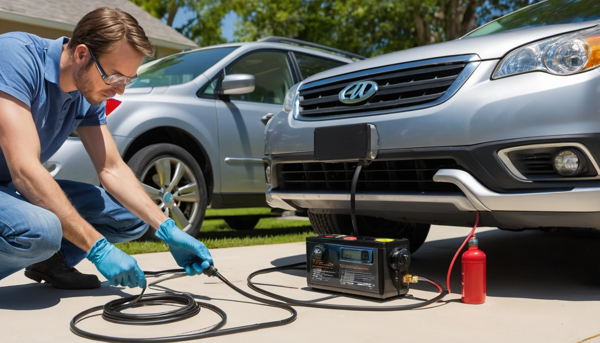How to recharge car AC with Freon the right way? Learn easy, step-by-step instructions to stay cool and save money.
How to Recharge Car AC with Freon – Easy Guide for Cool Rides
Is your car blowing warm air on a blazing summer day? 🥵 That’s a sign your AC system might be low on Freon. But don’t sweat it—you can fix this yourself without spending big bucks at the shop.
In this guide, we’ll show you exactly how to recharge your car AC with Freon—step-by-step. It’s easier than you think, and with a few tools and the right info, you’ll feel that refreshing chill in no time. ❄️
Let’s dive in and get your ride cool again! 😎
🚗 What Is Freon and Why Does It Matter?
Freon is the refrigerant that keeps your car’s AC blowing cold air. Without it, your system can’t absorb heat from inside your vehicle.
When levels are low:
- Your AC blows warm or lukewarm air
- You hear strange sounds from the AC unit
- The compressor keeps cycling frequently
Recharging your system restores cooling power and extends the AC system’s life.
🧰 Tools and Supplies You’ll Need
Before you begin, gather everything in one spot.
Here’s what you’ll need:
- A can of R-134a Freon (or R-1234yf for newer cars)
- AC recharge kit with gauge and hose
- Protective gloves and safety glasses
- Thermometer
- Owner’s manual (for port location & refrigerant type)
Tip: Always double-check your car’s refrigerant type before starting!
📍 Locate the Low-Pressure Port
Every car AC system has two ports:
- High-pressure port (Do NOT use this one)
- Low-pressure port (This is where Freon goes in)
To find the low-pressure port:
- Pop the hood and locate the AC lines
- Look for a port labeled “L” or “LOW”
- Check your manual if it’s hard to find
🧊 Table: Common Refrigerant Types by Year
| Model Year Range | Likely Refrigerant Type | Notes |
|---|---|---|
| Before 1995 | R-12 | Requires retrofitting for modern refills |
| 1995–2016 | R-134a | Most common type in older cars |
| 2017 & newer | R-1234yf | Eco-friendly, newer standard |
🔧 Prep Your Car for the Recharge
Don’t start spraying Freon just yet!
First, do this:
- Park on a level surface in a shaded area.
- Turn off the engine and let it cool.
- Put on gloves and glasses.
- Start the engine and set the AC to max with the recirculation mode ON.
This ensures the AC system is running and ready to accept refrigerant.
🌡️ Check Current Pressure with the Gauge
Attach the recharge hose to the low-pressure port. Read the pressure on the gauge.
General rule of thumb:
- 25–40 PSI = Normal when AC is on
- Below 20 PSI = Needs a recharge
- Above 45 PSI = Do NOT add more Freon
Too much refrigerant can damage your system! ⚠️
🛠️ How to Add Freon Step-by-Step
Now the fun begins! Follow these steps carefully:
- Shake the Freon can well.
- Attach it to the recharge hose and gauge.
- Connect the hose to the low-pressure port.
- Hold the can upright and press the trigger.
- Add Freon in short bursts—about 10 seconds at a time.
- Watch the pressure gauge.
- Stop when you reach around 35–40 PSI.
- Remove the hose and close the port.
That’s it! You’ve recharged your car AC like a pro. 👏
💨 Table: AC Performance by Pressure Level
| Pressure Reading | Cooling Performance | Action Needed |
| 0–20 PSI | Weak/no cooling | Recharge ASAP |
| 25–40 PSI | Good cooling | Normal operation |
| 45+ PSI | Risk of damage | Stop adding Freon |
🕵️♂️ Check for Leaks (Just to Be Safe)
If your system keeps losing Freon, you might have a leak.
How to spot a leak:
- Use UV dye or an electronic leak detector
- Check AC lines and connections
- Look for oily residue or hissing sounds
Fix leaks before recharging again.
🧊 How Long Does a Recharge Last?
A proper recharge can last 1–3 years, depending on:
- Age of your vehicle
- System health
- Climate conditions
If you’re recharging more than once a year, it’s time to see a pro.
🤔 Can You Use Too Much Freon?
Absolutely. Overcharging the AC system is dangerous.
Too much Freon can cause:
- Compressor damage
- Higher pressure levels
- Reduced cooling performance
Always stay within the recommended PSI range.
📉 Table: Signs of an Overcharged AC System
| Symptom | What It Means |
| Warm air blows out | System is overloaded |
| AC compressor shuts off | Pressure too high |
| Strange noises | Internal AC stress |
🧊 Tips to Keep Your Car AC Cold Longer
Want to avoid frequent recharges? Try these:
- Run your AC weekly for 10 minutes, even in winter ❄️
- Keep cabin filters clean
- Park in the shade
- Use windshield sunshades
Small habits keep your system in top shape!
💵 Cost to Recharge at Home vs. Mechanic
| Option | Average Cost | Notes |
| DIY at Home | $30–$60 | One-time investment |
| Mechanic Shop | $120–$250 | Includes diagnostic & labor |
✅ Safety Tips You Should Never Ignore
Working with Freon can be dangerous if you’re not careful.
Always:
- Wear gloves and eye protection 🧤👓
- Avoid open flames
- Work in a ventilated area
- Don’t overcharge the system
📘 When to Call a Professional
DIY recharges are great—but they’re not for every situation.
Call a mechanic if:
- The AC blows warm after recharge
- You hear grinding or clunking noises
- Pressure readings are erratic
Your system might need more than just Freon.
🔄 Recap: Recharge Your Car AC the Right Way
Let’s review the steps:
- Identify low-pressure port
- Check pressure with gauge
- Attach Freon can with hose
- Add refrigerant slowly
- Stop at 35–40 PSI
- Remove the hose and check performance
Boom! You’re ready to ride cool again. 😎
❓FAQs
How do I know if my car AC needs Freon?
If the air blows warm, the AC cycles often, or you hear odd noises, it’s time for a recharge.
Can I recharge my car AC myself without a gauge?
It’s not recommended. Gauges help avoid overcharging and protect your system.
How often should I recharge my car AC?
Typically every 1–3 years unless there’s a leak or system issue.
What happens if I overcharge my car AC with Freon?
You may damage the compressor or reduce cooling performance. Stop at safe PSI levels.
Is it safe to drive right after recharging AC?
Yes, as long as everything is sealed properly and there are no leaks.
References
https://www.familyhandyman.com/project/how-to-recharge-your-car-ac/



Leave a Reply